Home » Gemstones » Fancy Sapphire
Fancy Sapphire
Sapphires occur in many colors beyond blue.
Author: Hobart M. King, PhD, GIA Graduate Gemologist
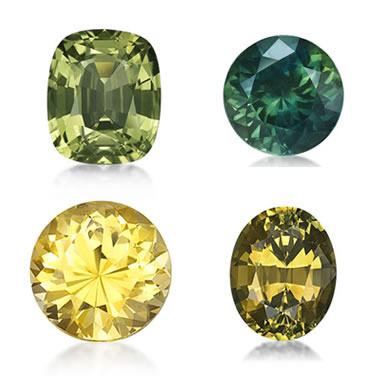
Fancy Sapphires from Australia: These colorful sapphires were produced at the Capricorn Sapphire Mine in Central Queensland, Australia. The mine produces deep blue sapphires and fancy sapphires in a wide range of yellow, green, and bluish green hues. The gems above are all natural-color sapphires without any treatments. The photos are used here with permission of Richland Gemstones, former owners of the Capricorn Sapphire mine.
What Are Fancy Sapphires?
A fancy sapphire is a gem-quality corundum that is any color other than red, blue, or colorless. The mineral known as corundum occurs in an infinite number of colors. When it is red, it is known as "ruby," when blue it is known as "sapphire," and when colorless it is known as "white sapphire." All other colors of gem-quality corundum are "fancy sapphire."
Table of Contents
Fancy Sapphire Sources
Sri Lanka, India, Myanmar, Thailand, and Australia have historically been important sources of fancy sapphire. Minor amounts have been produced in numerous other countries. In the United States, Montana has been a source of fancy sapphires for over 100 years. In the 1960s sapphire was named the "official state gemstone." That attention helped Montana sapphires of all colors attract the patronage of state residents and a steady stream of tourists and visitors.
During the past few decades, Africa has become an important source of fancy sapphires. Deposits in Tanzania, Kenya, Madagascar, Ethiopia, Nigeria, and other countries are producing these colorful gems.
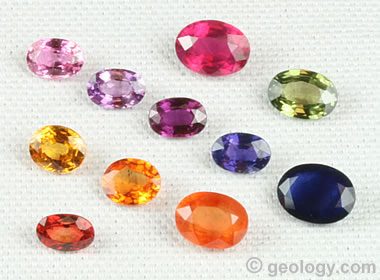
Corundum as ruby, sapphire, and fancy sapphire: Gem-quality corundum is a highly prized and valuable material. When it is bright red in color, it is called "ruby." When it is blue, it is called "sapphire." Colorless corundum is called "white sapphire." Gem-quality corundum of any other color is called "fancy sapphire." All of the stones in this photo were mined in Africa.
Natural Color in Corundum
Corundum has one of the greatest natural color ranges in mineralogy. It occurs in hues of red, orange, yellow, green, blue, and purple. This is a bit of a surprise because corundum is an allochromatic mineral. "Allochromatic" means that pure corundum (Al2O3) is colorless or white. Corundum of other colors is produced when trace amounts of other elements or defects in the corundum crystal lattice cause selective absorption of certain wavelengths of light.
The causes of color in ruby and sapphire are well researched and documented. Chromium is the primary cause of the red color of ruby and the color of pink sapphire. A combination of iron and titanium causes the color of blue sapphire.
The cause of color in the many hues of fancy sapphire is less well researched. Vanadium can cause a grayish blue to green color. Iron and a missing electron can produce a strong yellow color. Iron alone can cause a pale yellow color. Chromium with a missing electron can cause an orange color. Interactions between trace elements and lattice defects produce many other colors. The most popular colors are usually pure hues, such as red, orange, yellow, green, blue and purple. All of these, with the exception of emerald green, are found naturally in sapphire.
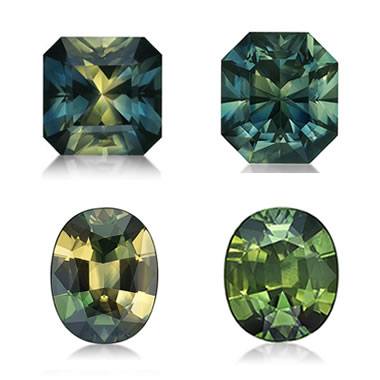
Parti Sapphires: The gems in the photo above are beautiful examples of parti-colored sapphires. They are gemstones cut from rare sapphire crystals that have two or more zones of distinctly different colors. These parti sapphires were produced at the Capricorn Sapphire Mine in Central Queensland, Australia. The photos are used here with permission of Richland Gemstones, former owners of the Capricorn Sapphire Mine.
Parti-Colored Sapphires
Parti sapphires are an especially fancy variety of fancy sapphire. They are gemstones cut from sapphire crystals that have color zones of two or more distinctly different colors. These crystals are cut in a way that allows two or more color zones of the sapphire crystal to be part of a single gemstone. This produces a multicolor gemstone that is beautiful, interesting, and absolutely unique. They can also be cut in ways that blend the different colors in the crystal.
Parti-colored sapphires are not seen in commercial jewelry where a manufacturer must buy large numbers of gemstones that are carefully matched for their size, cut, and color. Instead they are purchased by gem collectors or jewelry designers who want to create interesting one-of-a-kind jewelry items.
The cutters who transform the multicolored crystals into beautiful gemstones must study the rough stone and then fashion it into a cut stone that takes advantage of its unique color opportunities. The result is a gemstone that changes color depending upon the angle of viewing, the angle of incident light, and how that light travels through different color zones within the stone.
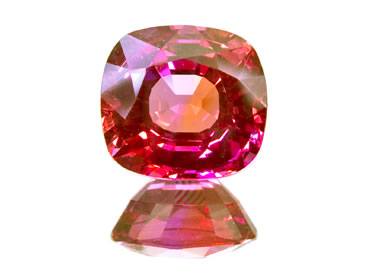
Padparadscha Sapphire: This orangy pink cushion-cut padparadscha sapphire has a rich saturation and weighs 2.28 carats. Image by Wiener Edelstein Zentrum, used here under a Creative Commons license.
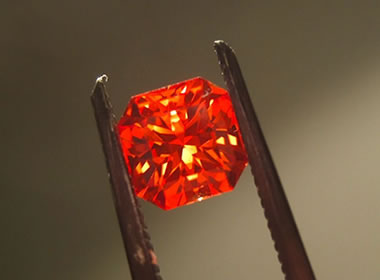
Padparadscha Sapphire: This padparadscha sapphire has an attractive pinkish orange color. Compared to the image above, you can get some appreciation of the great color range that might be applied to the padparadscha name. Public domain image by Alextryan.
What is a Padparadscha Sapphire?
Padparadscha is a trade name used for pinkish orange to orange-pink sapphires with a rich saturation. Gems with the padparadscha color are sold for higher prices than any other fancy sapphire.
Padparadscha sapphires are highly desired by people throughout the world, but especially in Sri Lanka and India. There they can sell for prices that rival what is paid for the finest blue sapphires and the finest red rubies.
The word "padparadscha" is derived from the Sinhalese word for "lotus blossom" which inspired the Sri Lankan desire for gemstones of similar color.
Unfortunately, there is no widely accepted definition of the hues, tones and saturations that bracket the padparadscha color. As a result, the color of gemstones that should be called "padparadscha" is subject to individual interpretations. Disagreements often arise over the grading of a gem and the use of the padparadscha name. The disagreements are fueled by the high prices paid for the gem.
If you really want to get into the definition of a padparadscha, then you should read An Essay on the Meaning of Padparadscha by Richard Hughes. In his essay, Mr. Hughes explores the definition of padparadscha sapphire and traces the early history of the name. Most interestingly, he presents the results of a survey that he conducted with nine experienced colored stone dealers. These dealers defined the term, associated their idea of the padparadscha color with common color terms, and bracketed their perception of the padparadscha color range on a detailed color gradient chart. His essay should be read by anyone who contemplates spending serious money on a gem that they hope will stand up to the name "padparadscha." [1]
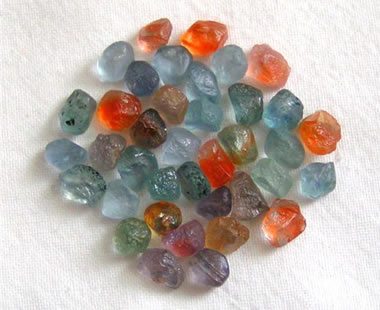
Heat-treated Sapphires: This photo shows about 49 carats of rough Montana sapphire from the El Dorado Bar that have received heat treatment. This photo is used with permission of 46 Degree Resources.
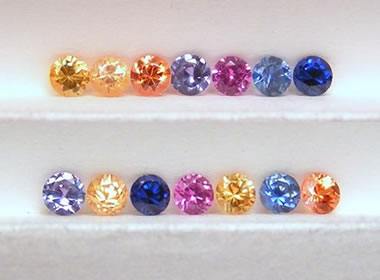
Sapphire color suites: These "color suites" contain colorful fancy sapphires from the Dry Cottonwood Creek area of Montana. The stones in the top row measure 2.5 mm each, and the stones on the bottom are 2.6 mm each. All stones have been heat treated. Photo is used with permission of 46 Degree Resources.
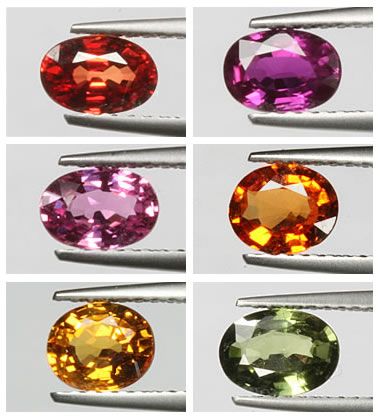
Fancy Sapphires: A collection of sapphires. Clockwise from top left: a reddish orange beryllium-heat-treated sapphire weighing 0.62 carats from Tanzania; a pinkish purple heated sapphire weighing 0.62 carats from Tanzania; a mandarin orange beryllium-heat-treated sapphire weighing 0.66 carats from Tanzania; a green heat-treated sapphire weighing 0.87 carats from Australia; an orangy yellow beryllium-heat-treated sapphire weighing 0.77 carats from Tanzania; and, a purplish pink heated sapphire weighing 0.66 carats from Madagascar. Almost all fancy sapphires have received heat or beryllium-heat treatment to improve their color.
Fancy Sapphire Treatments
Today, almost all corundum that enters the marketplace has been treated to improve its clarity and color. Most buyers accept this fact and gladly purchase treated gems. However, many buyers have a strong desire for gems that are completely natural in appearance and have not been treated in any way. They are buying a natural treasure and want it to display its natural beauty. For this reason they are highly selective in their shopping.
Untreated gemstones are always more valuable than treated stones of equivalent color and quality. In addition, treated stones may have different care and cleaning requirements. For these reasons, any treatments that have been done to a gemstone should be disclosed to the buyer in advance of a sale.
Heat Treatment
The most common treatment used with fancy sapphires is heating. Heat treatment can improve the color of a gemstone. Heating can darken light stones, lighten the color of dark stones, and can sometimes completely change their color. Heating can also dissipate certain inclusions and improve the clarity of a gem.
In the past, many sapphires with unmarketable color or clarity were discarded. Today treatment can convert many of them into attractive and marketable gems that many people enjoy.
Irradiation
Another sapphire treatment is irradiation. This is done by exposing gem materials to a source of strong radiation. As an example, irradiation can transform pale yellow sapphires into beautiful orange gems. One disadvantage of irradiation is that it is often not permanent. Irradiated sapphires will sometimes fade slowly over time or during prolonged exposure to light.
Lattice Diffusion
Lattice diffusion is another treatment used to enhance the color of sapphire. At high temperatures, foreign atoms can diffuse into the lattice of sapphire crystals. In the crystal lattice, these atoms can alter the way that light passes through and change the sapphire's color.
In 2001, gem dealers in Thailand began selling African sapphires in vivid yellow, orange, and pink colors with no treatments disclosed. The colors were beautiful but outrageous, and experienced sapphire buyers became suspicious. The Thais were heating the gems in the presence of beryllium that diffused into the crystal lattice of the sapphires.
This situation produced a trust problem in the sapphire market. Today, most sellers of lattice-diffusion sapphires provide proper disclosure, and commercial buyers have more knowledge of potential treatments to protect themselves and their customers. This is one more reason for retail buyers to patronize knowledgeable and trusted vendors.
| Fancy Sapphire Information |
|
[1] The Ownership of Words: An Essay on the Meaning of Padparadscha by Richard Hughes, an article on the Ruby-Sapphire.com website.
[2] Ruby and Sapphire - A Gemologist's Guide by Richard W. Hughes with Wimon Manorotkul and E. Billie Hughes, a book published by Lotus Gemology, 816 pages. |
Expanding the World's Sapphire Resource Through Treatment
In the past many sapphires were too cloudy or off-color to be used in the gem and jewelry industry. These unmarketable sapphires were usually left in the stream or dumped with the washed sediment. The discovery and use of various treatments now allows many of these once-unmarketable stones to be transformed into gems of surprising color and appearance. Treatment discoveries may have expanded the marketable sapphire resource more than all of the geological discoveries combined. It is possible that some historically rich sapphire deposits will be reworked to recover materials that can now be made marketable using new treatment methods.
| More Gemstones |
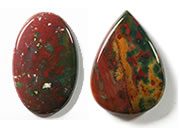 |
Bloodstone |
 |
Rock Tumblers |
 |
Diamond |
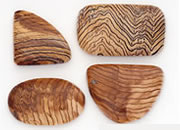 |
Opalized Wood |
 |
Tourmaline |
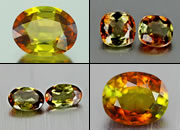 |
Andalusite |
 |
Blue Gemstones |
 |
100+ Gems |

Find Other Topics on Geology.com:

|

| ||

|

| ||

|

| ||

|

|

